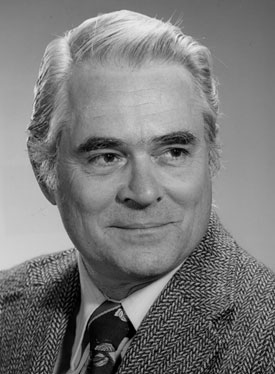UC Berkeley Press Release
Francis Moffitt, leading figure in photogrammetry, dies at 84
BERKELEY – Francis H. Moffitt, professor emeritus of civil and environmental engineering at the University of California, Berkeley, and a prominent name in the field of surveying and photogrammetry, has died at the age of 84.
Moffitt died of complications from pneumonia on Saturday, April 21, at his home in Berkeley.
 Francis Moffitt |
"Moffitt was very well-regarded internationally in the photogrammetry and surveying areas," said Carl Monismith, professor emeritus of civil engineering and a colleague of Moffitt's since 1951. "The textbooks he wrote, "Surveying" and "Photogrammetry," were really the standards by which other books on the topic were judged."
Photogrammetry, which is the quantitative determination of the shape, size and position of photographed objects from measurements made on the images, and photo interpretation, the qualitative analysis and evaluation of the nature of the photographed objects, represent the broad field now known as remote sensing.
"Moffitt was skilled in evaluating and reconstructing events as they happened in three dimensions from measurements and analysis of images in single or overlapping photographs," said James M. Anderson, UC Berkeley professor emeritus of civil engineering and a 32-year colleague of Moffitt's in the fields of photogrammetry and surveying.
Moffitt often applied those skills to determine the likely causes of vehicle and industrial accidents. "Moffitt was quite outstanding in the use of photogrammetric and surveying procedures for the use of forensics in court," said Anderson. "He was very good at recreating the scene based upon pictures, and was also known for his skill and judgment as an expert witness in court cases involving accidents."
Moffitt's colleagues credit him with helping to transform surveying techniques through a project with Hewlett Packard to develop the electronic distance measuring device, which uses sound waves that bounce off solid targets to a handheld reflector to determine distances, both indoors and outdoors.
Moffitt did not hesitate to use photogrammetry in innovative ways, including applications in bioengineering. He published numerous papers on the use of photogrammetry in dentistry and orthodontics to study teeth and jaw movements, and in hip replacement or prosthesis surgery to image joint movement.
He was also a pioneer in the use of off-the-shelf cameras for close-range photogrammetry in such applications as determining the configuration of ship waves or structural deformations in beam connections.
"In all of these innovations and applications, Moffitt was a master at using the very basic and fundamental principles of photogrammetry and surveying to solve problems," said Anderson. "If electronic computations were absolutely necessary for a particular job, he used them. On the other hand, if the task could be accomplished using a pair of photos, a pocket stereoscope, an engineer's scale, and some tracing paper, then that was his favored method, which would invariably yield the desired results."
Moffitt was born Oct. 16, 1922, in Akron, Ohio, where he was raised. "He grew up loving maps and the outdoors, and took up photography in high school," said his daughter, Kathleen Vinci.
After high school, he enlisted in the U.S. Army Air Corps just prior to the attack on Pearl Harbor. During World War II, he was stationed at an Army Air Corps photo laboratory in Panama, processing images of the war in the Pacific.
After his service ended, he enrolled in Syracuse University, where he studied surveying and photogrammetry. He earned his bachelor's and master's degrees in civil engineering in 1949 and 1950, respectively.
His career after graduation reflected his continued dedication to the field of photogrammetry and mapping. He instructed courses on the topic at Syracuse University, and then followed that with stints as a topographic engineer at the U.S. Geological Survey, the U.S. Army Corps of Engineers and the National Park Service.
In 1951, he joined the UC Berkeley engineering faculty as an assistant professor, rising to the ranks of associate professor in 1957 and professor in 1964. He retired in 1987 as a professor emeritus of civil engineering.
Colleagues remember him as a strong instructor, garnering praise from both UC Berkeley students and from professionals who attended the many short courses he taught over the years.
Moffitt earned many distinctions throughout his career, including election to an honorary membership at the American Society of Photogrammetry and Remote Sensing (ASPRS), which is the organization's highest honor. He received numerous presidential citations from ASPRS, where he served as vice president and then president between 1976 and 1979.
He also served as director of the Professional Practices Division of ASPRS, and was a trustee of the ASPRS Foundation. On the international scene, he worked as a foreign correspondent for the International Society for Photogrammetry and Remote Sensing.
Moffitt is survived by his wife, Mary Kathleen Boni Moffitt, of Berkeley, Calif.; daughters, Mary Elmstrom of Woodland, Calif., Eileen Frelier of Three Forks, Mont., Kathleen Vinci of Richmond, Calif., Ann Zacharias of Pittsfield, Maine, Madeleine Gerdes of Los Altos, Calif., and Margaret Goebel of Mountain View, Calif.; and sons, Nicholas Moffitt of Gig Harbor, Wash., and Anthony Moffitt of Tyler, Texas; and 16 grandchildren.

